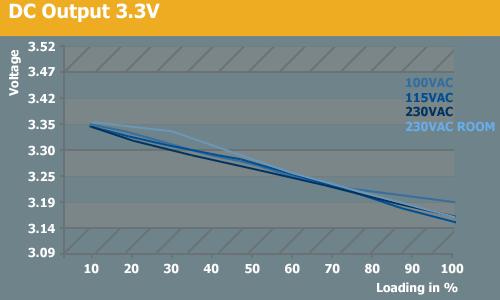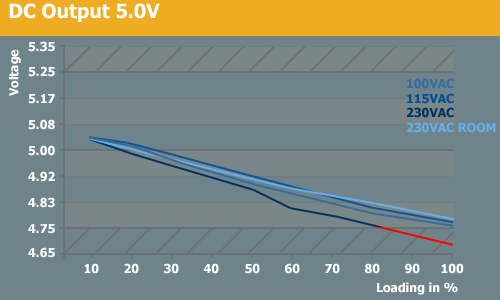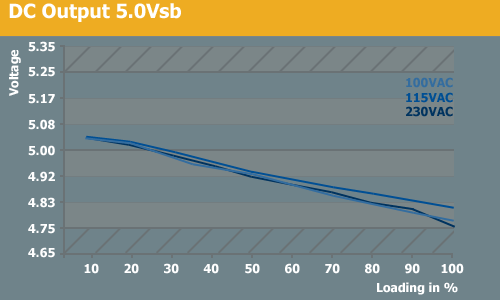Silverstone Decathlon DA650: A modular alternative
by Christoph Katzer on August 8, 2007 12:30 AM EST- Posted in
- Cases/Cooling/PSUs
Test Setup
As usual we are testing with our Chroma programmable loads to fully load each rail to a specific amount. This is important to get truly accurate results and not merely approximate values. The tests are conducted in two different temperature environments. One is normal room temperature of 25-26°C, while the second environment goes from room temperature and increases steadily up to 50°C. Especially during the higher temperatures we will see how good the power supplies are and what they're really made of. Components inside will perform much worse at higher temperatures, but we expect any good quality PSU to deal with such test conditions without failing.
Note: If you would like to know more about our testing methodology, equipment, and environment, please read our PSU testing overview.
3.3V DC Output

The 3.3V rail is a bit better at the Decathlon than the Olympia. It drops with increasing load but that doesn't fall under the minimum specified voltage. The decreasing voltage doesn't have much to do with temperatures since the voltage drops are all nearly identical regardless of ambient temperature or input voltage. During transient load testing we have also seen good results. The Decathlon works quite well with changing loads and input voltages. It also showed no problems with a cold start that jumped from 0% to 100% load.
5.0V DC Output

The 5V rail has an outcome similar to that of the Olympia OP650. It's a little bit better but the voltage still drops under the specified limitation of 4.75V when using a 230VAC input at higher ambient temperatures.
5Vsb Output

From the stability point of view it is not a surprise to see a decrease in the 5Vsb rail, but it is still within specifications and shouldn't be a problem.
12V DC Output

The 12V rail is very stable and doesn't even come close to the lower limits. Given that the 12V output is arguably the most important, we are pleased to see that it also provides the best results. Still, Silverstone could work on minimizing voltage drops for all of the output rails.
As usual we are testing with our Chroma programmable loads to fully load each rail to a specific amount. This is important to get truly accurate results and not merely approximate values. The tests are conducted in two different temperature environments. One is normal room temperature of 25-26°C, while the second environment goes from room temperature and increases steadily up to 50°C. Especially during the higher temperatures we will see how good the power supplies are and what they're really made of. Components inside will perform much worse at higher temperatures, but we expect any good quality PSU to deal with such test conditions without failing.
Note: If you would like to know more about our testing methodology, equipment, and environment, please read our PSU testing overview.
| DC Output Rails | |||||||||
| PSU Load | 3.3V Amps | 3.3V Wattage | 5V Amps | 5V Wattage | 5Vsb Amps | 5Vsb Wattage | 12V Amps | 12V Wattage | Wattage All Rails |
| 10% | 1.45 | 4.86 | 1.82 | 9.16 | 0.23 | 1.16 | 4.16 | 50.50 | 66 |
| 20% | 2.91 | 9.69 | 3.63 | 18.11 | 0.46 | 2.31 | 8.33 | 100.79 | 131 |
| 30% | 4.36 | 14.34 | 5.45 | 26.98 | 0.69 | 3.44 | 12.49 | 150.51 | 195 |
| 40% | 5.81 | 16.06 | 7.27 | 35.62 | 0.93 | 4.60 | 16.65 | 199.80 | 256 |
| 50% | 7.27 | 23.70 | 9.08 | 44.04 | 1.16 | 5.71 | 20.82 | 248.80 | 322 |
| 60% | 8.72 | 28.17 | 10.90 | 52.43 | 1.39 | 6.80 | 24.98 | 297.51 | 385 |
| 70% | 10.17 | 32.54 | 12.72 | 60.67 | 1.62 | 7.86 | 29.15 | 348.63 | 450 |
| 80% | 11.63 | 36.98 | 14.53 | 68.58 | 1.85 | 8.94 | 33.31 | 394.39 | 509 |
| 90% | 13.08 | 41.20 | 16.35 | 76.36 | 2.08 | 9.94 | 37.47 | 440.95 | 568 |
| 100% | 14.53 | 45.33 | 18.17 | 83.76 | 2.31 | 10.95 | 41.64 | 487.60 | 628 |
3.3V DC Output

The 3.3V rail is a bit better at the Decathlon than the Olympia. It drops with increasing load but that doesn't fall under the minimum specified voltage. The decreasing voltage doesn't have much to do with temperatures since the voltage drops are all nearly identical regardless of ambient temperature or input voltage. During transient load testing we have also seen good results. The Decathlon works quite well with changing loads and input voltages. It also showed no problems with a cold start that jumped from 0% to 100% load.
5.0V DC Output

The 5V rail has an outcome similar to that of the Olympia OP650. It's a little bit better but the voltage still drops under the specified limitation of 4.75V when using a 230VAC input at higher ambient temperatures.
5Vsb Output

From the stability point of view it is not a surprise to see a decrease in the 5Vsb rail, but it is still within specifications and shouldn't be a problem.
12V DC Output

The 12V rail is very stable and doesn't even come close to the lower limits. Given that the 12V output is arguably the most important, we are pleased to see that it also provides the best results. Still, Silverstone could work on minimizing voltage drops for all of the output rails.










7 Comments
View All Comments
eetnoyer - Wednesday, August 8, 2007 - link
...reviews of power supplies for people who aren't building a quad SLI system and don't want to spend $100 and up?Christoph Katzer - Wednesday, August 22, 2007 - link
...patience.crimson117 - Wednesday, August 8, 2007 - link
Should change to:
mostlyprudent - Wednesday, August 8, 2007 - link
Perhaps my expectations are messed up, but I have yet to be impressed by any of the units reviewed thus far. Then again, when spending $150 to $200 for a PSU, I am going to set my sights very high.Super Nade - Wednesday, August 8, 2007 - link
They used 3 x Primary caps, which is more expensive than 1 450uF, but since they are in parallel, the ESR reduces significantly. Although this may have a minimum bearing on the proceedings (secondary side is more important), there is less stress on the PWM/switching transistors.I think you may have issues calibrating your setup, given that every single PSU you have reviewed seems to have larger than usual voltage drops.
yyrkoon - Wednesday, August 8, 2007 - link
Given this, and that the rails do not seem to be solid/heatsink is too small, I think the PC power and cooling PSU is still the better buy.Besides that PC Power and Cooling is a well respected PSU OEM, why even bother with something else in the same price range.
Who makes this PSU anyhow ? I know it is silverstone branded, but I am fairly certain they did not make it.
Super Nade - Wednesday, August 8, 2007 - link
Impervio Electronics Corp, Taiwan.